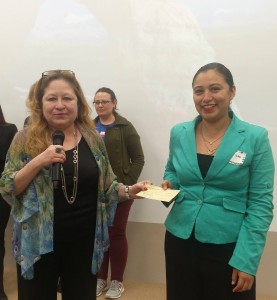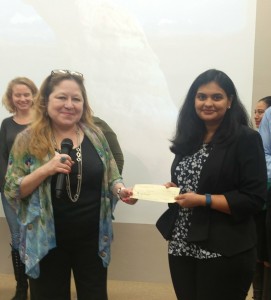72nd ANNUAL MEETING
Subtropical Agriculture and Environments Society
CONFERENCE PROCEEDINGS
February 9, 2018
SAE Proceedings-2018
Student Poster presentation Winners:
First Place:

Metagenomics Characterization of Rhizobacterial Community Structure Over Two Period of Cultivation of Non Modified and Transgenic Cotton
Lourdes Vital L.*, José A. Narváez Z. and Alberto Mendoza H.
Centro de Biotecnología Genómica-Instituto Politécnico Nacional, Boulevard del Maestro s/n Esq. Elías Piña, Col. Narciso Mendoza, C.P. 88730 Cd. Reynosa, Tamaulipas, México Tel and Fax: 01(899) 925-1656.*E-mail address: cnet11_4@hotmail.com
The main objective was to determine relative abundance, bacterial diversity, and distribution of rhizobacterial communities in each type of genotype plant by using next-generation sequencing (NGS) at the V3 region of 16S ribosomal RNA gene amplicons over a two year cultivation period. We identified the structure of rhizobacterial communities by using QIIME (Quantitative Insights into Microbial Ecology) platform. Soil before sowing and rhizosphere soil derived from non-modified, transgenic 1 (herbicide tolerance) and transgenic 2 (herbicide tolerance and insect resistant) cotton plants were collected at vegetative stage across two years of cultivation period (2015-2016). The taxonomic analysis indicated that the prominent phyla in soils before sowing were Proteobacteria, Acidobacteria, Actinobacteria, and Firmicutes. However, phyla with major abundance at rhizosphere level were Proteobacteria, Acidobacteria, and Actinobacteria during vegetative stage in 2015 and 2016. However, in rhizosphere soil, we found that the abundance of Cyanobacteria phylum was increased at rhizosphere derived from transgenic 2. The alpha diversity was higher in the soil before sowing than rhizosphere soil. Statistical results showed that transgenic cotton (1 and 2) harbored the number of bacterial biomarkers than non-modified plants. Finally, Non-metric multidimensional scaling (NMDS) results showed three main groups: 1) soil samples before sowing, 2) rhizosphere derived from non-modified and transgenic cotton collection in the 2015 year and 3) rhizosphere derived from non-modified and transgenic cotton.
Second Place:

Development of Integrated Pest Management for Barnacle Scale in South Texas Citrus
Ruby Ann Saldaña and Mamoudou Sètamou,
Texas A&M University-Kingsville
The prevalence of barnacle scale (Ceroplastes cirripediformis) populations and the damage caused to citrus trees and fruit in South Texas citrus orchards have demonstrated the need to make improvements on current integrated pest management (IPM) strategies. Although many citrus growers have implemented successful insecticidal spray programs, frequent outbreaks of barnacle scale, as a result of poor pesticide stewardship, require a constant quest of management strategies adapted to the changing pest profiles in citrus groves. Due to the scarcity of information regarding barnacle scale in South Texas groves, several ecological and IPM components of this pest were studied. Population density was monitored throughout several commercial groves and biological control agents were also collected. Identification of barnacle scale natural enemies will foster the implementation of biological control and ensure the sustainability of its control program. A field trial was conducted to test the efficacy of commercially available insecticides and data collected was used to make improved management recommendations to citrus growers. Weeds commonly found harboring barnacle scale within citrus groves were also identified and management of these alternative host plants was suggested in order to prevent resurgence of barnacle scale.
Third Place:

Biolistic Transformation of Carrizo Citrange with Whole Plasmid and Minimum Cassette using Mcherry Fluorescent Protein as Visual Marker
Mounica Tammineedi, Eliezer Louzada Texas A&M University-Kingsville Citrus Center
A visual selectable marker Mcherry red fluorescent protein was used to establish a protocol to biolistically transform Carrizo citrange plants. Whole plasmid containing Mcherry gene (Mcherry3) was coated on gold particles (1.0μm) and bombarded on epicotyl segments. Explants were bombarded at target distances of 6cm and 9cm; 1550psi and 1350psi rupture disk pressures; 0.3cm and 0.6cm bombardment gaps; 25psi of Hg Vacuum pressure. Transgene expression was visualized under fluorescent light with excitation maximum at 587nm and emission at 610nm after 3-4 weeks from bombardment. Number of transient and stably transformed explants were recorded. Effective conditions for shoot regeneration were investigated, with antibiotic (Kanamycin 100μg/ml) selection starting at time zero, and 24h after bombardment. Transformation of Mcherry gene will be verified by PCR after plant regeneration. Preliminary results showed high transgene expression in explants pre-cultured for 5-7 days before transformation. Further, evaluation for high-expression and low copy transgenic plants shall be conducted with whole constructed plasmid and minimum cassette (Fragment of plasmid DNA containing a selectable marker, screenable marker and a gene of interest flanked by restriction sites).